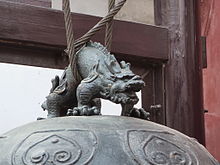Pulao (dragon)


Pulao (Chinese:
Pulao appeared in Chinese literature already during the Tang dynasty. The Tang dynasty scholar Li Shan (
海中 有 大 魚 曰鯨,海邊 又 有 獸 名 蒲 牢 ,蒲 牢 素 畏 鯨 ,鯨 魚 擊 蒲 牢 ,輒大鳴 。凡終欲 令 聲 大 者 ,故 作 蒲 牢 於上,所以 撞之者 為 鯨 魚 .[1]In the sea there is a big fish called whale, and on the shore there is a creature whose name is pulao. The pulao has always been afraid of the whale. Whenever the whale strikes [or attacks] him, pulao cries [or roars] loudly. Thus those who want to make a loud [bell] would put a pulao on top. Therefore the bell-striker would be made [in the shape of] a whale.[2]
During the Ming dynasty, the pulao (in the form tulao) appeared in the influential list of fantastic creatures appearing in architecture and applied art, which was compiled by Lu Rong (1436-1494) in his Miscellaneous records from the bean garden (
徒 牢 ,其形似 龍 而小,性 吼 呌、有 神力 ,故 懸 於鐘上 。The tulao's form is like that of a dragon, but small. By its nature it likes to roar, and has supernatural strength. [They] used to hang bells [by the tulao]. [3]
Later on, the pulao, with similar descriptions, was integrated into various lists of the Nine Children of the Dragon compiled by later Ming dynasty authors such as Li Dongyang and Yang Shen.[4]
Notes
[edit]- ^ Quote from Li Shan's text given in Yang Jingrong and Liu Zhixiong (2008)
- ^ In the article The Bell of the Bailin (Cypress Grove) Temple, the following English translation is offered: "There is the big fish called the whale in the sea and the animal called pulao at the seaside. The pulao is always afraid of the whale. Whenever the whale attacks the pulao, the latter roars. Whoever wishes to make a bell sonorous puts a pulao design on it. The striker is the whale."
- ^ Quote from Lu Rong's Shuyuan zaji, given in Yang Jingrong and Liu Zhixiong (2008)
- ^ Yang Jingrong and Liu Zhixiong (2008)
